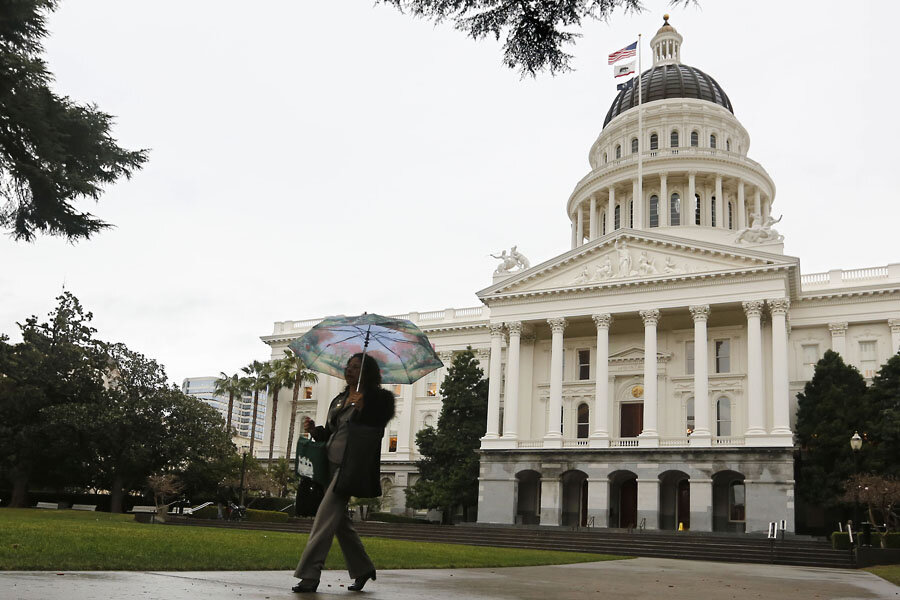Why more voters are going independent in California
Loading...
| LOS ANGELES
Both the Democratic Party and the Republican Party are losing ground in voter registration in America’s most populous state – following a nationwide trend. Though still reliably "blue," California has adopted some political reforms designed to moderate partisanship in the state's political system, and some suggest that over time those changes will make the major political parties less relevant.
Of some 17.7 million registered voters in the state, 43.6 percent identified as Democrats in 2013, down a full percentage point since 2010, while the GOP share of the registered vote has dropped more than 2 percentage points to 28.7 percent, according to new figures in a just-released Secretary of State report, required by law.
Over a longer time frame, the losses to established parties are even more striking. Since 1997, the Democratic Party's share of the registered vote in California has dropped 3.2 percentage points, as Republicans lost 7.5 points, according to the report.
Meanwhile, registration for "no party preference" (NPP) rose to 20.9 percent in 2013, up from 20.2 percent in 2010 and 11.9 percent in 1997. Another 6.8 percent of Californians identify with smaller parties, such as the American Independent Party, Americans Elect Party, Green Party, Libertarian Party, or Peace and Freedom Party.
“The latest California voter registration numbers present some interesting shifts in how voters are becoming more like free agents about their partisanship and less about a rigid commitment to one side or the other,” says David McCuan, a political scientist at Sonoma State University.
Nationwide, the share of registered voters identifying as independents has hit a record high of 42 percent, according to a recent Gallup poll. As in California, the "increasing shift to independent status has come more at the expense of the Republican Party than the Democratic Party," the poll concludes.
Although some headlines across the state give the impression that both parties are losing ground, the figures should not be construed as equally distributed, some analysts say.
Roughly 20 percent of independent voters in California lean Republican and 40 percent Democratic, says Eric McGhee, a research fellow at the California Public Policy Institute.
“They call themselves independent when asked, but when elections come around and they are pressed to commit, they vote Democrat,” he adds. “It means they still hold the views of Democrats but just aren’t super excited about it. So California is still solidly blue.”
In California, as across the country, the rise in numbers of voters who no longer want to identify with a political party is a result of people feeling that neither party reflects their views.
“They are generally people who feel that the Democrats have gone to the far left, and that Republicans have gone to the far right, and that they prefer the center,” says Gary Aminoff, vice chairman of the Republican Party of Los Angeles County. “People dislike the perception that, in Congress, there seems to be dysfunction because the parties won't work together.”
What is less clear, say Mr. McGhee and others, is how California’s top-two primary system plays into the state's long-term trend toward independent voters. California passed Proposition 14 in 2010, making it one of three states with the system (the other two are Washington and Louisiana). In statewide and congressional candidates in California, only the top two vote-getters in a primary advance to the general election, without regard to party affiliation.
“You used to have elections where voters could ignore the primary, since there would be a choice of two or more different party representatives. Now the primary voters pick the top two, and there will be a number of cases where the highest-turnout elections will not offer voters a choice between or among parties,” says John McGlennon, who chairs the Department of Government at the College of William & Mary in Williamsburg, Va.
That means that candidates in California can no longer count on securing their own party's base as a formula for making it to a general election. That change in the election rules encourages reaching beyond party lines and consensus-building, some analysts say.
Other California reforms, such as drawing district lines by a citizen committee rather than the legislature and establishing term limits as of 2012, magnify these trends and “have helped open up a free-for-all across many areas of the state," says Sonoma State's Professor McCuan.
One result, he and others say, will be lots of new faces in races, from governor to secretary of state to the state legislature – although still likely to favor Democrats.
“Discontent with the two established political parties is a growing national trend and, if California's model seems to result in broader consensus and moderation, we may see elements of it spill over into other states,” says Michael Shires, professor of public policy at Pepperdine University in Malibu, Calif.
“While prior elections required voters to affiliate to vote in primaries, everyone matters now as a potential vote," he adds. “This means both parties will have to work harder to earn votes from across the nonpartisan spectrum."
“In theory, at least, [all this] means there should be more centrist candidates who will have to appeal not just to their party political base, but also to less ideological independents,” says Los Angeles County GOP Chairman Aminoff. “I suspect that political parties will become less significant as time goes on.”
The Secretary of State survey showed that about 3 in 4 of California’s 24 million eligible voters are registered, an increase of about 751,000 since 2010.







